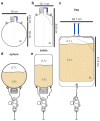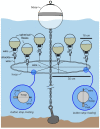Accessing Nystatin through Mariculture
- PMID: 34946737
- PMCID: PMC8708966
- DOI: 10.3390/molecules26247649
Accessing Nystatin through Mariculture
Abstract
Understanding our oceans and their marine ecosystems has enabled the development of sustainable systems for mariculture. While the bulk of studies to date have focused on the production of food, its remarkable expanse has inspired the translation of other markets towards aquatic environments. This manuscript outlines an approach to pharmaceutical mariculture, by demonstrating a benchmark for future prototyping. Here, design, field evaluation and natural product chemistry are united to successfully produce nystatin at sea. This study begins by evaluating new designs for culture flasks, illustrating a next step towards developing self-contained bioreactors for culturing in marine environments. Through pilot studies, an underwater system was developed to cost effectively produce cultures that yielded 200 mg of nystatin per deployment. Overall, this study demonstrates the potential for the practical culturing of microbes in a marine environment and provides an important next step for the fledgling field of molecular mariculture.
Keywords: drug development; mariculture; marine biotechnology; natural product production.
Conflict of interest statement
The author declares no conflict of interest.
Figures





Similar articles
-
Assessment of microplastics derived from mariculture in Xiangshan Bay, China.Environ Pollut. 2018 Nov;242(Pt B):1146-1156. doi: 10.1016/j.envpol.2018.07.133. Epub 2018 Aug 1. Environ Pollut. 2018. PMID: 30099319
-
Understanding impacts of organic contaminants from aquaculture on the marine environment using a chemical fate model.J Hazard Mater. 2023 Feb 5;443(Pt A):130090. doi: 10.1016/j.jhazmat.2022.130090. Epub 2022 Oct 3. J Hazard Mater. 2023. PMID: 36279653
-
Occurrence and ecological risks of 156 pharmaceuticals and 296 pesticides in seawater from mariculture areas of Northeast China.Sci Total Environ. 2021 Oct 20;792:148375. doi: 10.1016/j.scitotenv.2021.148375. Epub 2021 Jun 9. Sci Total Environ. 2021. PMID: 34157531
-
Human Health and Ocean Pollution.Ann Glob Health. 2020 Dec 3;86(1):151. doi: 10.5334/aogh.2831. Ann Glob Health. 2020. PMID: 33354517 Free PMC article. Review.
-
Vulnerability of China's nearshore ecosystems under intensive mariculture development.Environ Sci Pollut Res Int. 2017 Apr;24(10):8957-8966. doi: 10.1007/s11356-015-5239-3. Epub 2015 Sep 2. Environ Sci Pollut Res Int. 2017. PMID: 26330311 Free PMC article. Review.
Cited by
-
Evaluation of Physically and/or Chemically Modified Chitosan Hydrogels for Proficient Release of Insoluble Nystatin in Simulated Fluids.Gels. 2022 Aug 10;8(8):495. doi: 10.3390/gels8080495. Gels. 2022. PMID: 36005096 Free PMC article.
References
-
- Food and Agriculture Organization of the United Nations . The State of World Fisheries and Aquaculture. Food and Agriculture Organization of the United Nations; Rome, Italy: 2014.
-
- Gentry R.R., Alleway H.K., Bishop M.J., Gilles C.L., Waters T., Jones R. Exploring the potential for marine aquaculture to contribute to ecosystem services. Rev. Aquaculture. 2020;12:499–512. doi: 10.1111/raq.12328. - DOI
-
- Derome N., Filteau M., Ramesh N., Royam M.M., Manohar P., Leptihn S., Houston R.D., Bean T.P., Macqueen D.J., Gundappa M.K., et al. In: Microbial Communities in Aquaculture Ecosystems: Improving Productivity and Sustainability. Derome N., editor. Springer Nature; Cham, Switzerland: 2019.
MeSH terms
Substances
LinkOut - more resources
Full Text Sources

